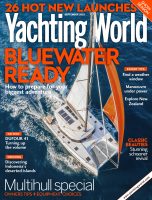In the sweltering heat of midsummer in the Ligurian Sea, temperatures and tensions were steadily rising on board 11th Hour Racing. Simon ‘Si Fi’ Fisher restlessly tidied lines in the…
Imoca 60
World’s fastest monohull: Malizia-Seaexplorer IMOCA 60
Followers of the IMOCA 60 fleet will know that two names have dominated the class over the past two generations when it comes to design: VPLP and Verdier. So, it’s no…
IMOCAs win race to Cherbourg with Macif first monohull in Rolex Fastnet Race
In the battle of the big boats it was the brand new IMOCA Macif, skippered by Charlie Dalin with Pascal Bidégorry which was first monohull home to take line honours in…
50th Rolex Fastnet Race starts: but early retirements pour in with furious conditions forecast
The 50th Rolex Fastnet Race got underway today, Saturday 22 July, with the largest offshore racing fleet ever setting off from Cowes in rain and 20-25 knot headwinds . With…
‘Gnarly’ but potentially record-breaking forecast for 2023 Rolex Fastnet Race
Strong headwinds are forecast for the start of the 50th Rolex Fastnet Race, which sets off tomorrow from Cowes, Isle of Wight to Cherbourg, France, via the iconic course around…
Rolex Fastnet Race 2023 stacked IMOCA fleet set to entertain
The famous Rolex Fastnet Race always provides an intriguing line up of amateur and professional teams all looking for race glory as they battle the 629nm course from Cowes, round…
11th Hour Racing declared winners of The Ocean Race after redress
Charlie Enright’s 11th Hour Racing Team has won The Ocean Race after a jury awarded them redress of 4 points in the final leg of the round the world race,…
The Ocean Race overall win down to jury decision after huge collision
The overall winner of The Ocean Race is likely to be decided in the protest room after a huge collision between 11th Hour Racing and Guyot-environnement – Team Europe shortly after…
Pro sailors on their Southern Ocean experience
“I’m so happy not to be alone,” an emotional Boris Herrmann said standing at the base of his 29m/95ft mast, a foot-long gash ripped into the carbon above his head…
640.9 miles in 24hrs: Holcim-PRB smashes monohull record
Kevin Escoffier’s IMOCA Holcim-PRB, competing in the The Ocean Race, has annihilated the 24-hour monohull sailing record by covering an incredible 640.9 miles on the fifth leg from Newport to Aarhus. This…
GUYOT environnement – Team Europe dismasted in The Ocean Race
Early this morning, Tuesday 9 May 2023, organisers of The Ocean Race have reported that GUYOT environnement – Team Europe has dismasted as the fleet race towards the finish of…
Crew changes aplenty as teams prepare for The Ocean Race leg 4
Crew rotation is proving to be a big feature in this edition of The Ocean Race and once again the crews are being mixed up on all boats as the…
Clarisse Crémer confirms new Vendée Globe sponsor, Alex Thomson heads team
It has been confirmed that Clarisse Crémer’s Vendée Globe campaign is back on with L’Occitane en Provence stepping in as headline sponsor, while British five-time Vendée Globe veteran Alex Thomson…
Alex Thomson buys Banque Populaire IMOCA, but skipper still to be confirmed
British four-time Vendée Globe competitor Alex Thomson has announced that his team has agreed to purchase the IMOCA 60 which Clarisse Cremer was set to race in the 2024 Vendée Globe before she…
The Ocean Race: is racing under autopilot ‘cheating’?
That’s not racing. It’s cheating. If you’re going to use the autopilot to sail around the world you might as well simply control the boat by remote control from home.”…
Vendée Globe: Meet the British skippers due to compete in 2024
As the 2024 Vendée Globe draws ever closer it looks like British fans will have plenty to shout about in the next edition as a bumper number of British skippers…
‘Demolition Derby’ begins in Leg 3 of The Ocean Race
Leg 3 of The Ocean Race was always expected to be an punishing test for the five IMOCAs and their crews, but it’s been a particularly tough start for the teams…
Wild start to leg 3 of The Ocean Race
It was an extraordinary ‘stop-go’ type of start to Leg 3 of The Ocean Race in Table Bay as the five-boat IMOCA 60 fleet set out on their 12,750 nautical…
How to follow The Ocean Race Leg 3 (and why you should)
This weekend five crewed IMOCA 60s will take to the startline for the third leg of The Ocean Race, on a month-long epic which is likely to be the toughest…
Banque Populaire drops out of the 2024 Vendée Globe
In early February Clarisse Cremer broke the news she had been dropped as skipper for the 2024 Vendée Globe by her sponsor Banque Populaire. Now, following a month of terrible…























